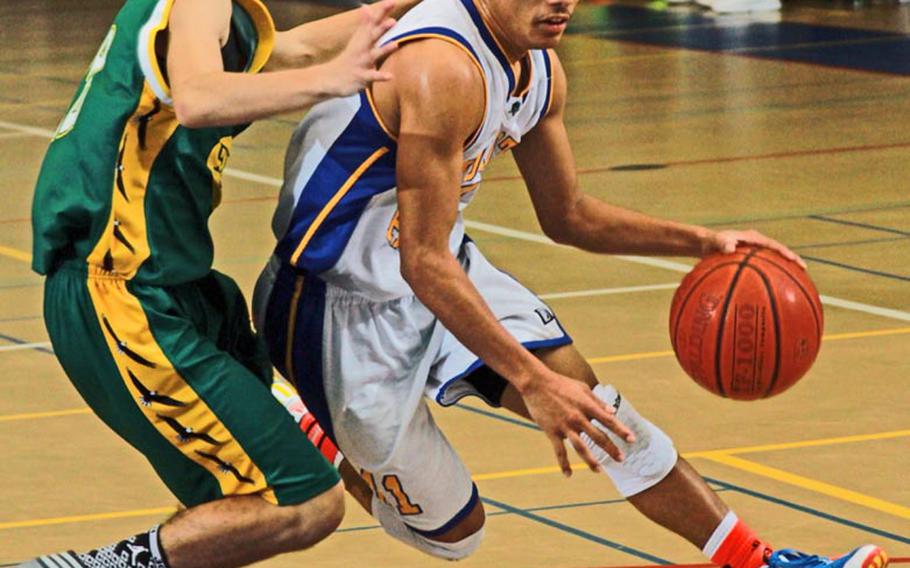
Yokota's Morgan Breazell drives to the basket against Robert D. Edgren's Izzy Leon during Friday's quarterfinal game in the 7th New Year Classic at Yokota Air Base, Japan. The Panthers won 75-59. Breazell was named the tournament MVP and played a critical role in helping the Panthers win the championship. In Saturday's 56-55 overtime win over Nile C. Kinnick in the semifinals, he hit three foul shots with no time left in regulation to send the game to overtime. Yokota beat Christian Academy Japan 49-47 for the title later Saturday. (Greg Holladay/Special to Stars and Stripes)
YOKOTA AIR BASE, Japan - For Morgan Breazell, no moment in last week’s New Year Classic basketball tournament loomed more critical.
He’d just missed a game-tying three-point attempt as time expired with Yokota trailing Nile C. Kinnick 51-48 in Saturday’s semifinal. But he was fouled as he shot, sending him to the foul line for three free throws. Make them, and the game goes to overtime and Yokota has a fighting chance to win. Miss at least one and the Panthers’ chances at the title evaporate.
“I just knew I had to hit the first two to relieve the pressure on me,” Breazell said. “Just try to tell myself it’s just like when I practice shooting by myself in the morning.”
Before a home crowd with its collective heart in its throat, he hit those first two shots. “After that, I knew the third one was good,” Breazell said.
Nothing but net. Overtime. Yokota held off the Red Devils and won 56-55, then edged Christian Academy Japan 49-47 in the championship.
Breazell’s moment of foul-shooting perfection proved a contrast to how the eight teams did for the rest of the tournament at the foul line. They combined to go 352-for-651, 54 percent, over the three-day event.
It’s emblematic of how far free-throw shooting has fallen on basketball’s importance scale since the mid-1970s, when the non-shooting foul was introduced first at the pro level, then later in college and high school. It was further diminished by the introduction of the three-point goal in the 1980s, longtime Pacific basketball observers said.
“Players aren’t practicing shooting,” coach Jon Fick of reigning two-time Far East Division I Tournament champion Kubasaki said. “Good shooters are also good foul shooters. Players these days just want to go out and play.”
The foul shot “is not as much glamorous as an alley-oop or a three-pointer,” Yokota coach Paul Ettl said, blaming what he calls the “ESPN Top 10” sports culture for the downtrend in foul shooting. “Kids just don’t think they’re all that important.”
Extensive research of scorebooks and stat sheets from Far East tournaments dating back to the 1960s and on the Internet reveal that the downtrend actually began well before ESPN debuted in 1979.
Official statistics ceased to be kept after the 1983 Far East tournament. Prior to that, the record for team free-throw percentage was 81 percent in 1970 by Canadian Academy, while the individual record for one tournament was 86 percent by T.J. Hardeman of Faith Academy in 1974.
Fast forward to the 1982-83 Yokota varsity season. The Panthers shot 52 percent, 252-for-485. In the 1993 Far East tournament, the 16 teams combined to go 547-for-1,016, 54 percent. Seoul American’s boys team in 2001-02 shot 66 percent, compared to 61 percent 10 years later.
John Thek, who coached Yokota for 14 seasons starting in 1985-86, recalls his high school days in New Jersey when Pequannock High featured four players who averaged 80 percent at the line.
His girls coaching counterpart Charlie Capps, who won Far East titles in 1989 and 1991, played at Lathrop High in Missouri in the 1950s. “Our coach was not happy if we shot less than 70 percent,” he said.
Back in those days, though, every foul was a shooting foul. “Somebody could get 28 to 30 points in one game and a third of those would be free throws, if not half,” Capps said. “We practiced free throws a lot and we also did more shooting on our own.”
“It put more of a premium on foul shooting,” said Yokota athletics director Tim Pujol, who played at Lake Highlands High in Dallas in the late 1970s.
He coached Yokota’s boys last year, in which the Panthers beat Robert D. Edgren 40-36 in the DODDS-Japan tournament, a game in which Yokota shot 12-for-15 from the line in the fourth quarter compared to Edgren’s 9-for-16.
“There’s your ball game,” Pujol said.
Players today would rather trade off a couple of extra feet to score a three-pointer than to hit a 15- to 17-foot jumper, Thek said.
“That was where the shot was back in my era,” he said.
It’s not as if players don’t practice, Breazell said, adding that he shoots as many as 500 in a week in mornings before school, and as many as 30 more each day in practice, and hits “about 70 to 75 percent” of them.
“Kids nowadays, they like the showman aspect of the game,” Breazell said. “They’re not worried about what matters. They don’t see it as a big part of the game, but it could come down to those last seconds as it did for me.”
What can improve foul-shooting percentage across the board?
“Your routine has to be the same every day,” he said. “You have to practice over and over, so when it comes to that situation, you’ll be ready for it.”
“There’s no reason they can’t be good shooters,” Ettl said.